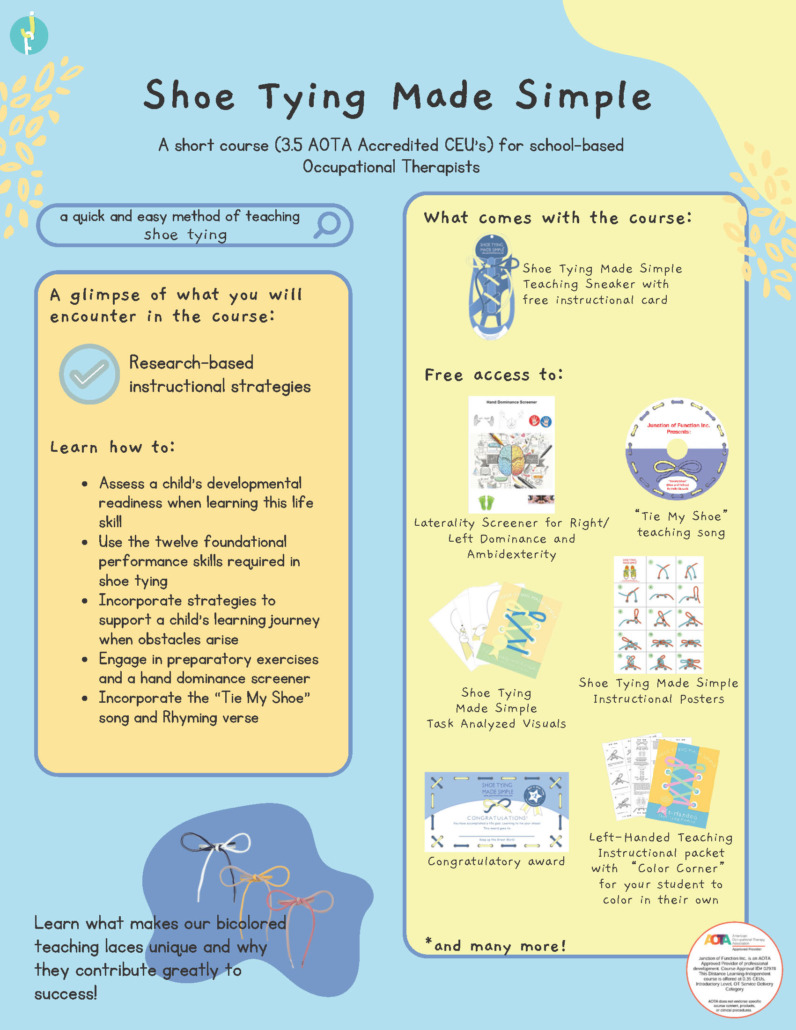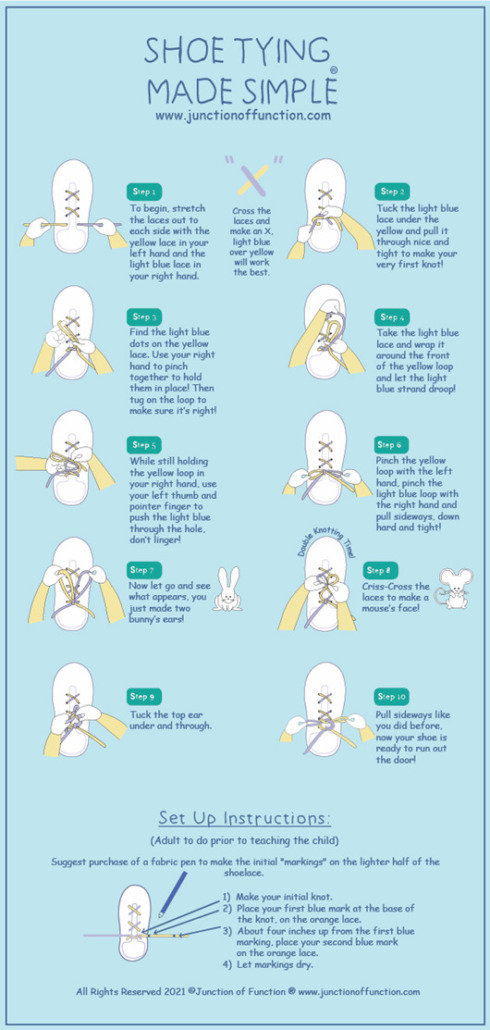Shoe Tying Task Analysis

When you were a kid, one of the first things you might have learned how to do around kindergarten and first grade was to tie your shoes. It might appear like a pretty basic task, but it can be super tricky. That’s because there’s a lot more to shoe tying than it seems. If you’re having trouble teaching children how to tie their shoes, don’t worry – you’re not alone. In fact, there are plenty of pediatric Occupational Therapists who specialize in teaching others how to tie their shoes properly. OTs often break the skill down into smaller steps. A shoe tying task analysis helps to take a closer look at each step in the shoe tying process.
SKILLS INVOLVED IN SHOE TYING
Before we get to the step by step directions for shoe tying, let’s review all of the foundational performance skills that children need to complete this intricate skill of shoe tying. There are several underlying skills that children need to have acquired before being able to tie their shoes.
FINE MOTOR SKILLS FOR SHOE TYING
To be able to tie your shoes, you need fine motor control of your fingers and hands. Children need to use a pincer grasp to hold the laces and loops. They need dexterity and a refined pincer grasp using just the tips of the fingers as well. Finally, they need to release this grasp to tie their shoes. This activity to open and close the fingers is necessary for independence.
VISUAL PERCEPTUAL SKILLS FOR SHOE TYING
This can be very challenging for children. They have to be able to determine visual-spatial concepts such as which lace is in front of the other, left/right, under/over, around, etc.
MOTOR PLANNING SKILLS – SHOE TYING TASK ANALYSIS
Children have to be able to plan and initiate a motor action to complete the skill of shoe tying. Throughout the entire shoe tying task analysis children are using motor planning skills.
FOLLOWING DIRECTIONS
Kids need to able to follow multistep directions and verbal prompts to complete the skill of shoe tying. This requires understanding language or picture symbols.
GRADING OF MOVEMENTS
When tying shoes, you need to use tactile discrimination to touch and hold the laces with the right amount of pressure. You then need to grade the movements of your muscles to pull the laces tight but not too tight or too lose.
MOTIVATION AND ATTENTION TO TASK
Is the child motivated to learn this skills? Do they have the attention span and/or appropriate behavior to work on practicing all of the steps?
POSTURAL CONTROL
You need to be able to maintain an upright posture while you use your hands to tie your shoes. This requires muscle strength in the trunk muscles to allow the hands to work freely.
SHOE TYING TASKS ANALYSIS WITH COLORED LACES
One way to teach shoe tying to children, is to use colored laces. The Shoe Tying Made Simple method designed by an experienced OT, use blue and yellow laces with added dots on the laces for an additional visual cue. The colored laces can reduce frustration and help provide more clear instructional strategies.
Use colored laces from the Shoe Tying Made Simple course or make your own by tying two different colored laces together and putting them in the shoe.
Step 1: Stretch the laces out to each side with the yellow lace in your left hand and the blue lace in your right hand. Cross the laces and make an X with the blue over the yellow lace.
Step 2: Tuck the blue lace under the yellow lace and pull it through to make the first knot.
Step 3: Use your right hand to make a loop with the yellow lace. Pinch the loop together.
Step 4: Wrap the blue lace around the front of the yellow loop.
Step 5: Continue to hold the yellow loop, push the blue lace through the hole.
Step 6: Pinch the yellow loop with the left hand. Pinch the blue loop with the right hand and pull tightly sideways and down.
DOUBLE KNOTTING
Step 7: Hold up the two loops.
Step 8: Cross the loops.
Step 9: Tuck the loop under and through.
Step 10: Pull tightly sideways and down.

WHEN TO USE THE SHOE TYING TASKS ANALYSIS WITH COLORED LACES
By providing colored laces and the simple teaching sneaker from the Shoe Tying Made Simple Course, can help children to overcome obstacles when learning how to tie their shoes. This is beneficial for all children including special education students, children with autism spectrum disorder, students with developmental disabilities and more.
The discrete steps supplemented by the colored laces can help the kids achieve independence!

Shoe Tying Made Simple Course
SHOE TYING TASK ANALYSIS WITHOUT COLORED LACES
If you do not have colored laces, or your students have already achieved independence with the colored laces and they are ready to move on to traditional shoe laces you can follow these steps.
Step 1: Stretch the laces out with one on the right side of the shoe and one on the left side of the shoe. Put one lace in each hand. Cross laces and make an X.
Step 2: Tuck the top lace under the bottom lace. Pull it through to make the first knot.
Step 3: Use your right hand to make a small loop with one lace. Pinch the right loop together with the right index finger and thumb.
Step 4: Use your left hand and wrap the other lace around the front of the pinched loop in the right hand.
Step 5: Continue to hold the loop with the right hand, push the left lace through the hole making another loop.
Step 6: Pinch each loop and pull tightly sideways and down.
SHOE TYING TASK ANALYSIS MAKING TWO LOOPS – BUNNY EAR METHOD
Students may benefit from trying a different step-by-step approach to shoe tying. This is called the bunny ear method. According to the creator of the Shoe Tying Made Simple course, the double bunny ear method caters to children that have more equal “ambidextrous” skills.
Step 1: Stretch the laces out to each side with one lace in each hand. Cross the laces and make an X.
Step 2: Tuck the top lace under the bottom lace. Pull it through to make the first knot.
Step 3: Use your right hand to make a small loop with one lace. Pinch the loop together and hold it with your right hand.
Step 4: Use your left hand to make a small loop with the other lace. Pinch the loop together and hold it with your left hand.
Step 5: Cross the loops to make an X.
Step 6: Tuck the top loop under the bottom lace and through.
Step 7: Pull tightly sideways and down.
WHAT TO DO WHEN CHILDREN ARE STILL STRUGGLING WITH SHOE TYING
If your students or children are continuing to struggle with this task here are some intervention ideas:
- try preparatory exercises to warm up the finger and hand muscles.
- using a rhyming verse or shoe tying poem to help them to remember the step of a task.
- backwards chaining – the adult completes most of the steps and the children finish the last step or few steps.
- if you are using a simple practice shoe, make sure the children are in the right position and looking at the top of the shoe.
- try video modeling for the children to refer to the steps.
- add dots using a fabric marker to your shoelaces to provide additional visual supports.
- not practicing when you need to get somewhere quickly. Practice shoe tying at first when you are not going anywhere.
- take baseline data and determine what step of the task needs more practice time.
- use a hand dominance screener (included in the Shoe Tying Made Simple Course) to determine if the children has right-hand or left dominance. You might need to adjust your teaching if the child is left handed.
- check the child’s developmental readiness. You may need to try this skill at a later date.
- more practice time!
DO YOU STILL NEED HELP WITH SHOE TYING?
This simple life skill can be very difficult to teach. Taught by an experienced Occupational Therapist, Shoe Tying Made Simple is an engaging and informative 3.5 hour AOTA approved virtual course that will teach you everything you need to know about shoe tying.
The Shoe Tying Made Simple AOTA approved course includes:
- 3.5 hours of virtual training with .35 CEUs from AOTA (you have one year to access this course)
- Research based instructional strategies to teach children how to tie their shoes
- Shoe Tying Made Simple Teaching Sneaker with Instructional Card – this will be SHIPPED to you after you register for the course
- Tie My Shoe Teaching Song Digital MP3 file
- Laterality Screening Tool for Right/Left Dominance and Ambidexterity PDF packet
- Task Analysis Visuals PDF
- Shoe Tying Made Simple Instructional Posters PDF to print
- Left Handed Teaching Instructional Packet PDF file
- Printable Award and more!
Occupational therapy providers will be able to provide a fun and supportive learning environment for their students as they learn this essential life skill. Purchase the Shoe Tying Made Simple Course today!




